DIY Chicken Waterer and Feeder from 5-gallon Buckets
on Oct 12, 2017, Updated Aug 21, 2024
This post may contain affiliate links. Please read our disclosure policy.
Spring is in the air, so it’s time to start preparing for backyard chickens! I will tell you everything you have ever wanted to know about Chicken Waterers and feeders and how to DIY your own from a 5-gallon bucket.
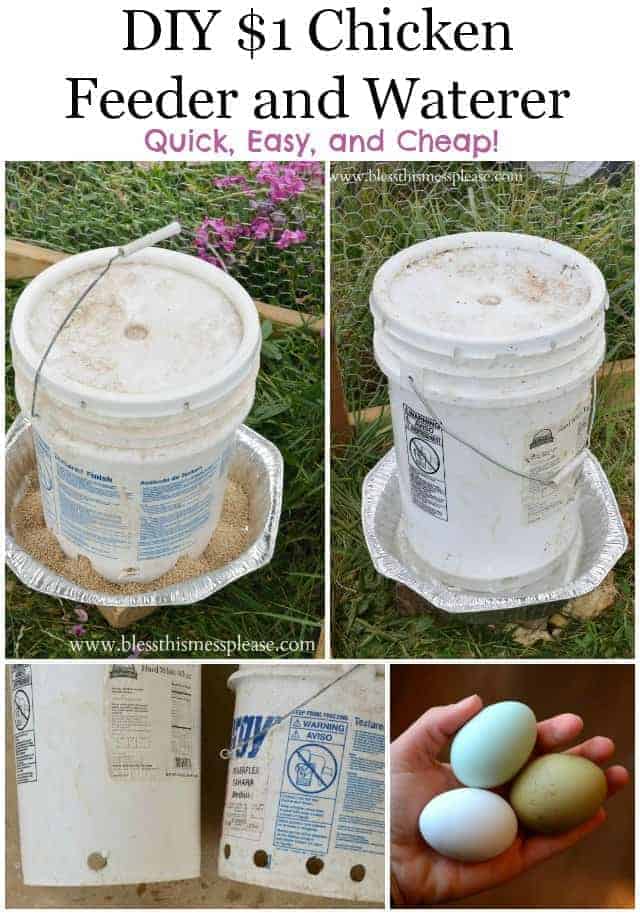
Providing animals with water to drink seems like a no-brainer, but there are many factors that go into watering chickens. For instance, how much water do chickens need, what type/material of waterer is best, how to keep the water clean, and how to DIY a simple and cost-efficient chicken waterer.
Appropriate access to clean water drastically influences how healthy a chicken is and how well it produces. If a chicken does not have ample water, they will stop laying eggs! Water also aids in the digestive process and helps a chicken eliminate waste.
When sufficiently hydrated, chickens can more effectively regulate their body temperature. A chicken that drinks clean, cool water also has a healthy brain. This will keep the animal in tip-top shape and its mind sharper to watch for predators.
And if they’re well-hydrated, they’ll keep laying those beautiful eggs for delicious meals like an egg and potato casserole, perfect for breakfast, lunch, or dinner.
Table of Contents
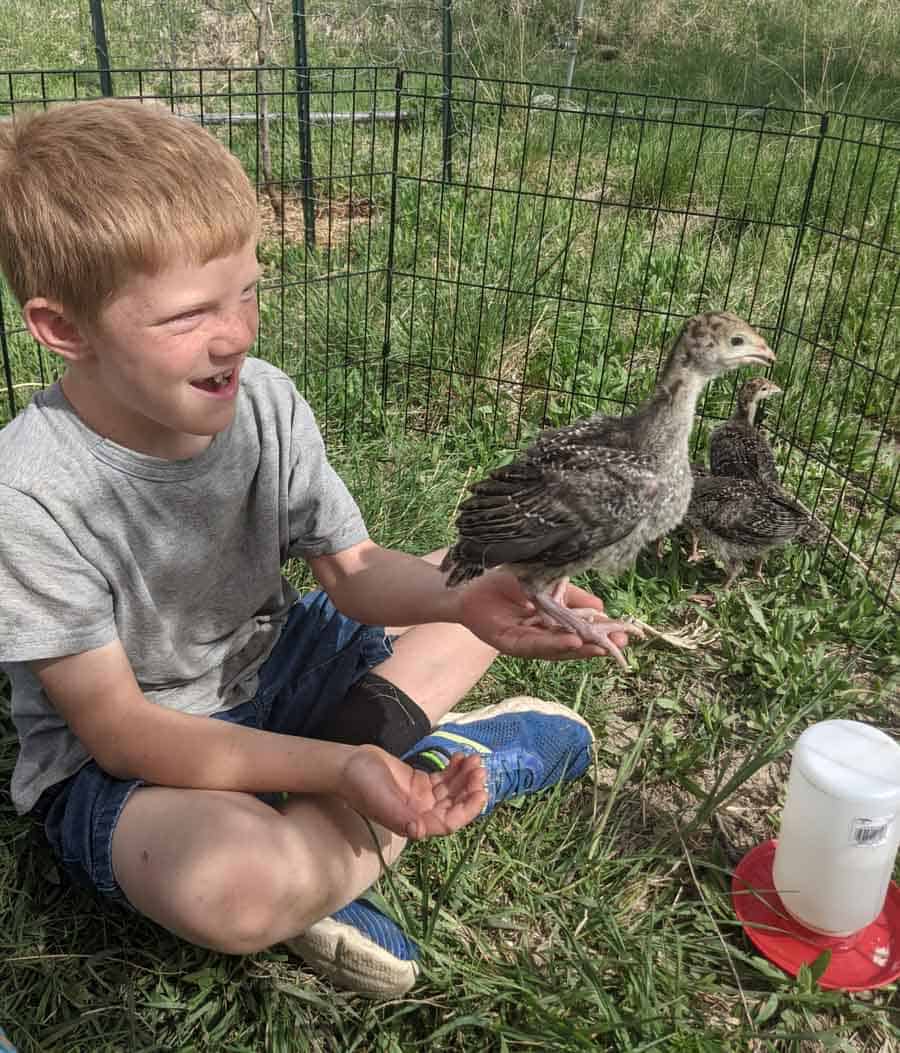
How Much Water Chickens Drink Per Day
It doesn’t seem like chickens drink much water because they just take small sips throughout the day. However, on average, a single chicken will drink about 1 pint of water daily. They will drink more if the temperature is hot.
Cool and Fresh Water, Please!
They also like cool, fresh water. If the water has been sitting out in the sun too long, hasn’t been refreshed regularly, or starts to get dirty from the chicken’s own doing, they may stop drinking. You don’t want a chicken that isn’t drinking, so remedy the issue quickly.
The process of chickens drinking water is fun to watch. Chickens use their tongue to push food to the back of their mouth to be swallowed, but that method doesn’t work for drinking.
If a chicken wants to drink water you will see them dip their beak into the water and rapidly tilt their head back to let the water drip down their throat. So you can imagine they can’t drink a whole bunch of water at once.
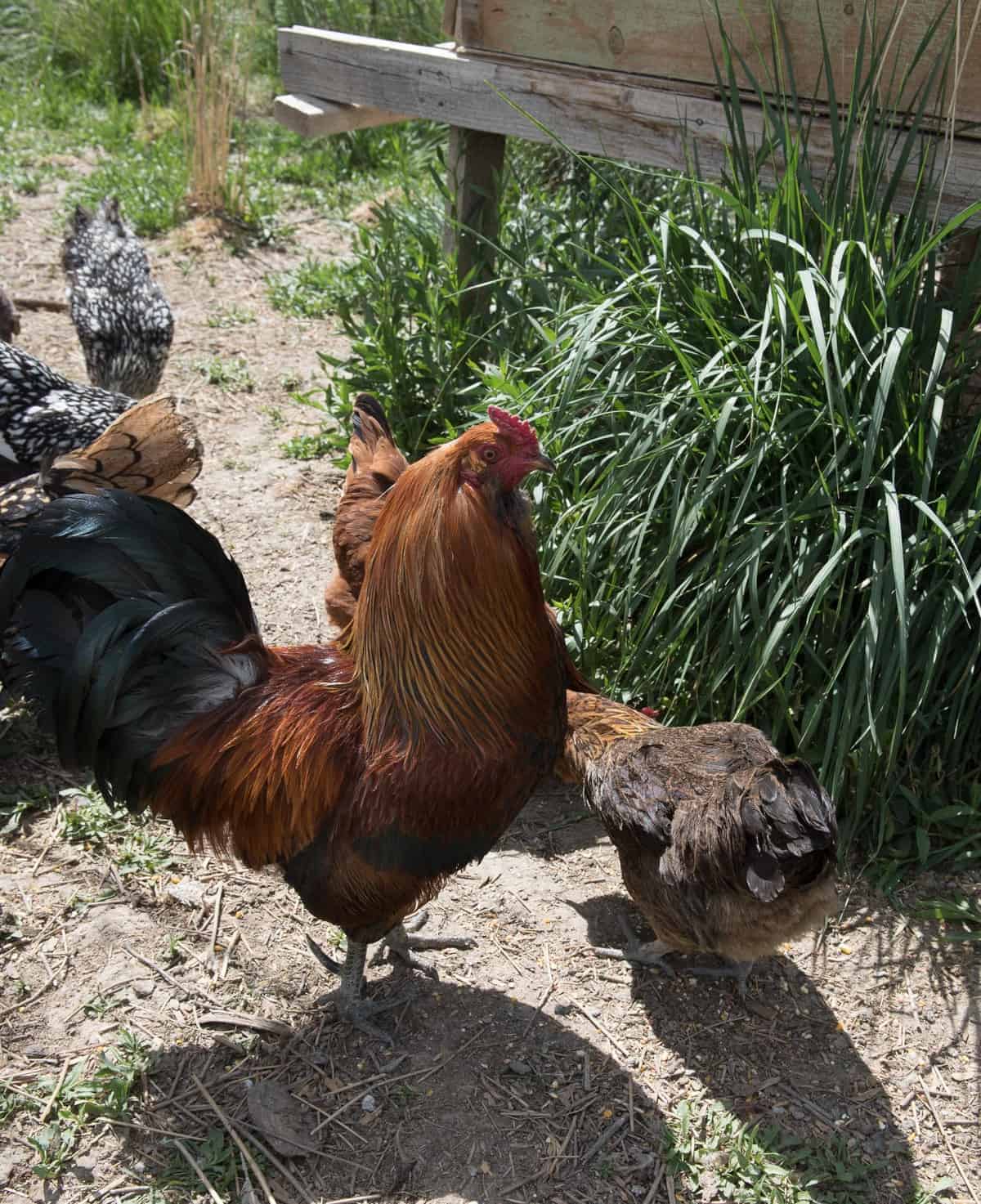
Tips for Keeping Chicken Water Fresh and Clean
Keeping the water you feed your chickens clean is essential.
- You should refresh their water daily to prevent bacteria buildup and algae forming.
- Sanitize the waterer at least weekly. Clean it with dish soap, a brush, or a diluted bleach solution.
- Place the water containers in shaded areas to prevent overheating and algae growth.
- Elevate the water containers off the ground to prevent dirt and droppings from getting into the water.
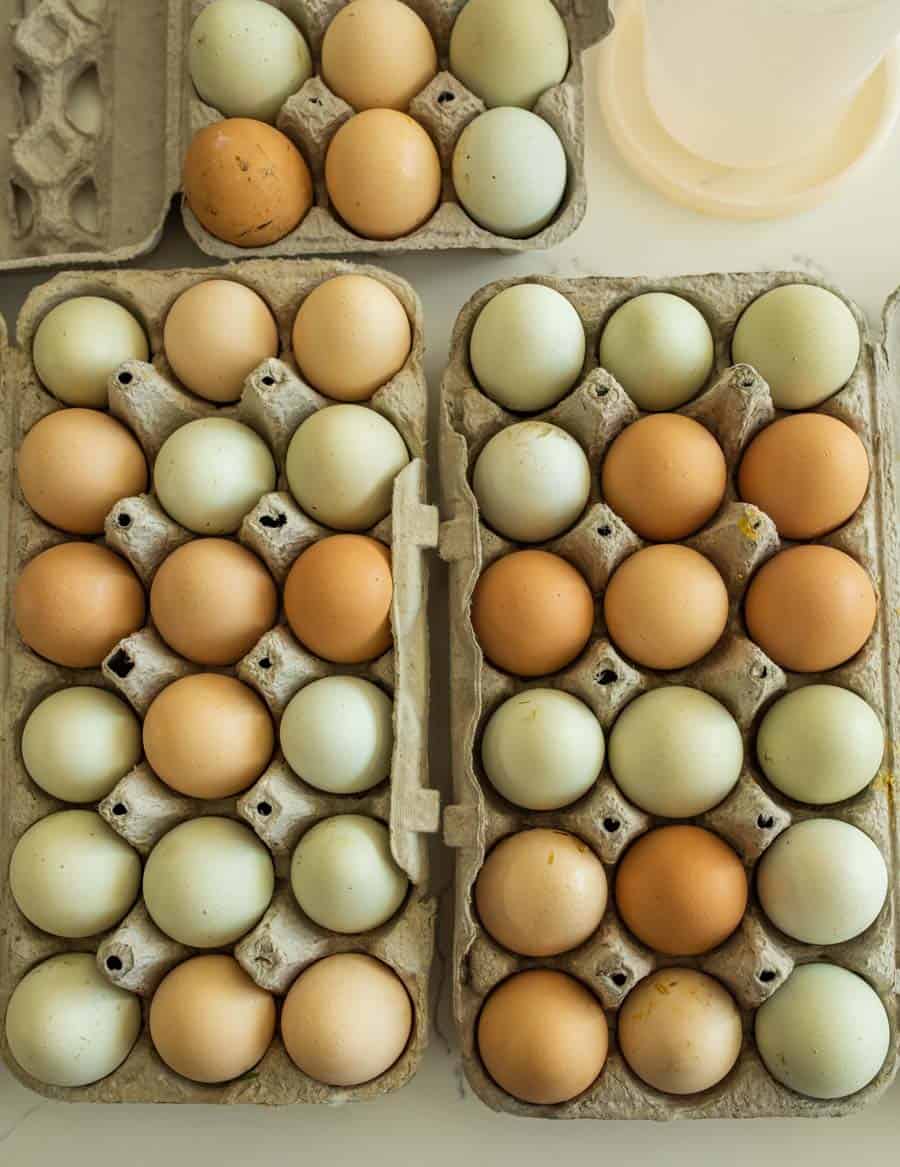
Project FAQs
Chickens typically do not need water at night. They sleep on their roosts until morning.
You want to place your waterers without direct sunlight to keep the water as cool as possible.
I plan for one large waterer per 6-8 chickens. Remember that each chicken will drink about 1 pint daily, so plan accordingly.
The general rule is that if it is safe enough for you to drink, your chickens can also drink it.
You will want to remedy the situation quickly if a chicken is dehydrated. When a chicken isn’t getting enough water, its egg-laying will slow down or stop completely. It will become lethargic, and you may notice it panting or having a pale comb.
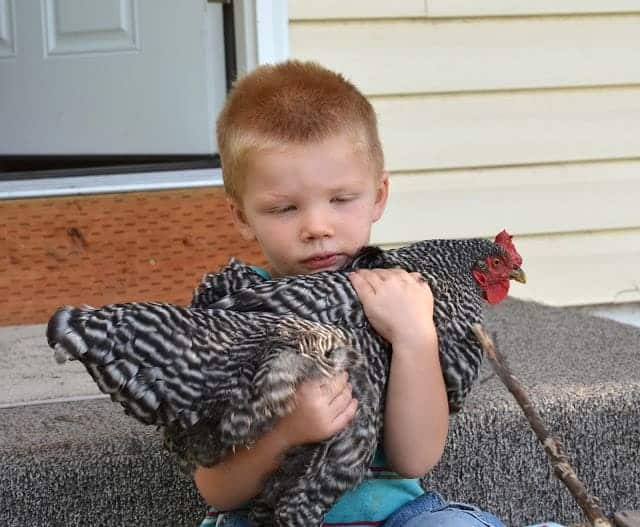
DIY Chicken Waterer and Feeder From 5-Gallon Buckets
Chicken waterers can come in various shapes, sizes, and dollar amounts and can be constructed from various materials. In my experience, you don’t need to break the bank to provide water for chickens. Your chickens will thrive if they have clean, fresh water and lots of it.
We have used this DIY version for chicken waterers for years and have found great success.
Materials Needed for Chicken Feeder and Waterer
- Two 5-gallon buckets with lids
- Drill
- 1-inch standard drill bit or paddle drill bit
- Two large foil roasting pans
Where to Get Materials
Buckets: Find a free source for the buckets. They are everywhere, really! Just ask your local sandwich shop to save you a few that the pickles come in. Bakeries are also a good source for free buckets.
Pans: Pick them up at the dollar store for a few bucks, or get these large feed pans.
How to Make the DIY Chicken Feeder
- Clean and empty a bucket
- Drill 1-inch holes around the bottom edge, spacing the holes about 2 inches apart.
- Place the bucket inside the pan, right-side-up (holes in the pan), and then fill it with chicken feed. The feed will pour through the holes into the pan, and as the chicken eats, more will come out.
- Replace the lid to the bucket so the chickens can’t get to the food from the top. Easy!
How to Make the DIY Chicken Waterer
- Clean and empty the 5-gallon bucket.
- Along the bottom edge of the bucket, drill two 1-inch holes opposite of each other.
- Place the bucket inside the pan, right-side-up (holes in the pan), and then fill it with water.
- Replace the lid and make sure that it has an airtight seal.
This seal is key!! The water will stop coming out of the holes once the water covers the holes completely if the lid is airtight.
If there isn’t a good seal, the water will keep running out of the bucket and overflow the pan. It’s a hydrodynamics thing—just ask my water engineer husband; he’d gladly explain it to you!
How to Make a DIY Chicken Feeder and Waterer – Picture Tutorial
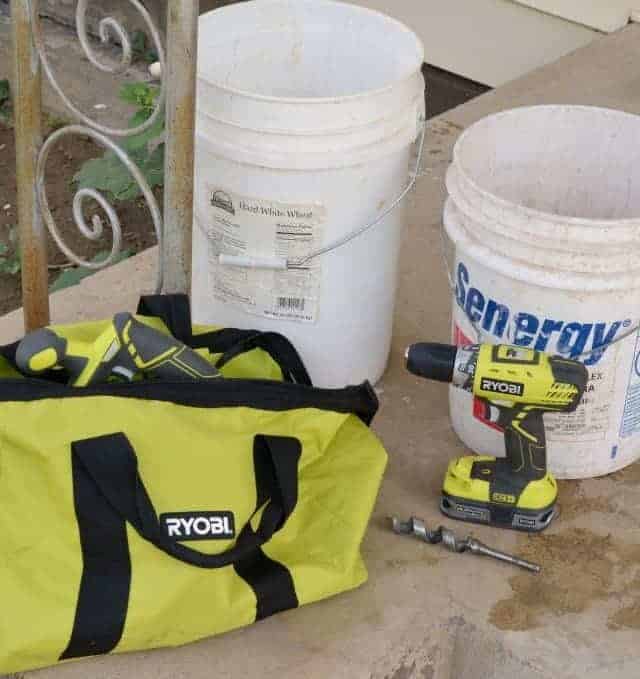
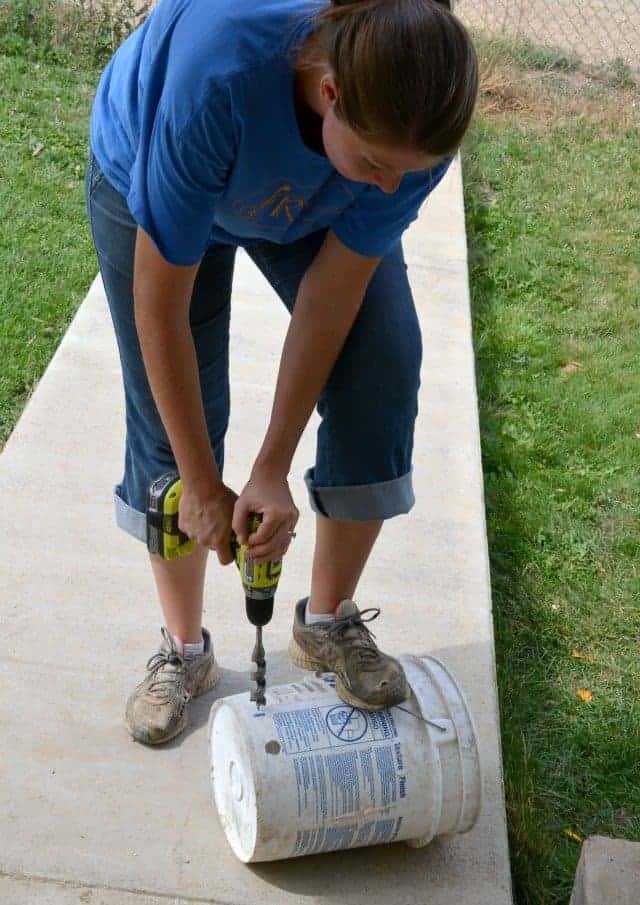
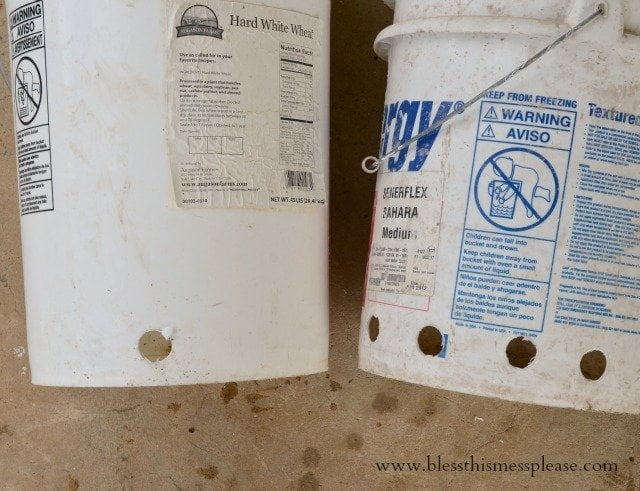

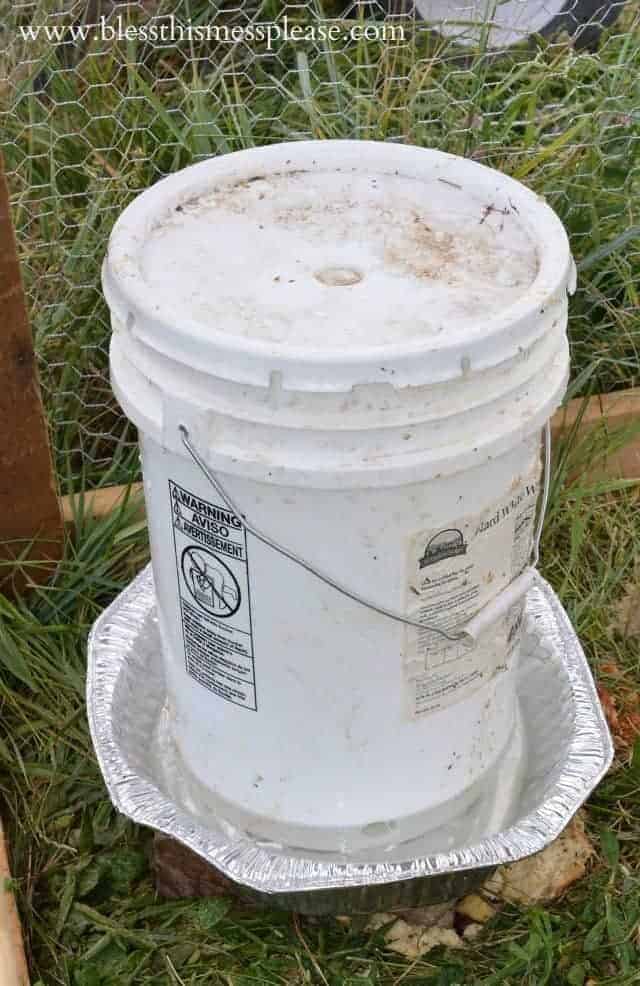
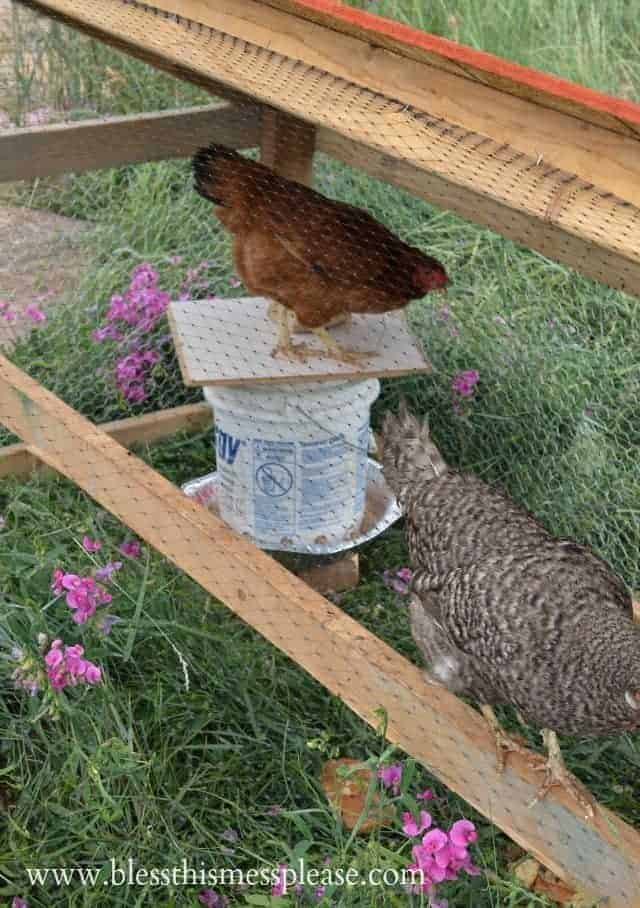
Sometimes life on the farm can be much simpler than we think, and this DIY chicken waterer and feeder from 5-gallon buckets is the perfect example. An easy and cheap way to provide an effective and reliable feed and watering system for your chickens.
If you’ve been bitten by the DIY spirit, you might try your hand at building a chicken coop for the little egg factory in your backyard. I believe happy chickens make more eggs!
Update: October 2017
I have been using these same buckets as a DIY chicken waterer and feeder for over 4 years, though I have upgraded from the foil turkey roaster pans. Those pans lasted about 6 weeks, but I was in it for the long haul.
I picked up some large (about 16 inches wide and 4 inches deep) round metal pans from our hardware store to replace the pans in these pictures. Similar pans are available on Amazon.
They cost me less than $10 each and have lasted 4 years. So for $20 total, instead of $2, I have a large feeder and waterer that I’ve used for years. They work great and I still highly recommend making these.
More Farm Fun!
Farm Animals
The Complete Guide to Building A Chicken Coop
Recipes by Cook Time
Easy Pumpkin Dog Treat Recipe
Did you try this project? Share it on Instagram, Facebook, and Pinterest!

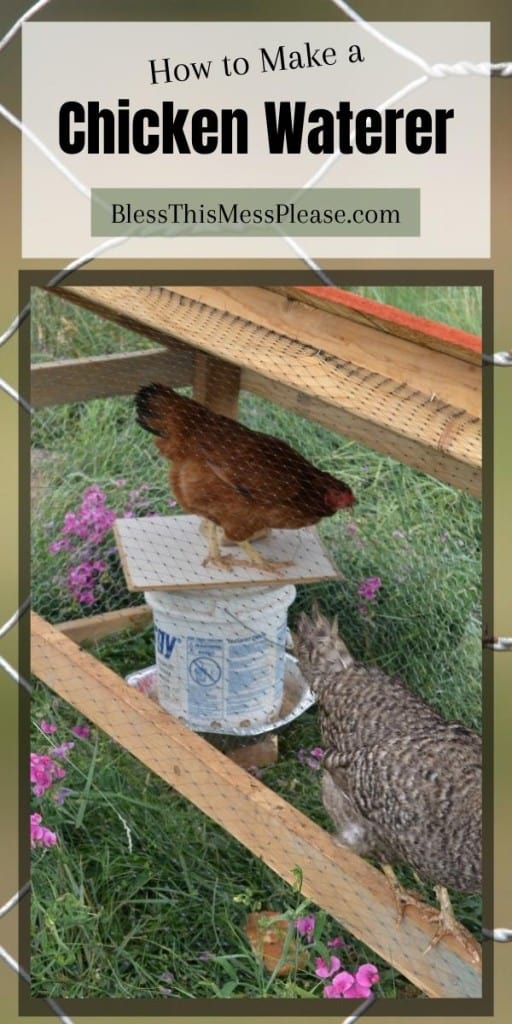
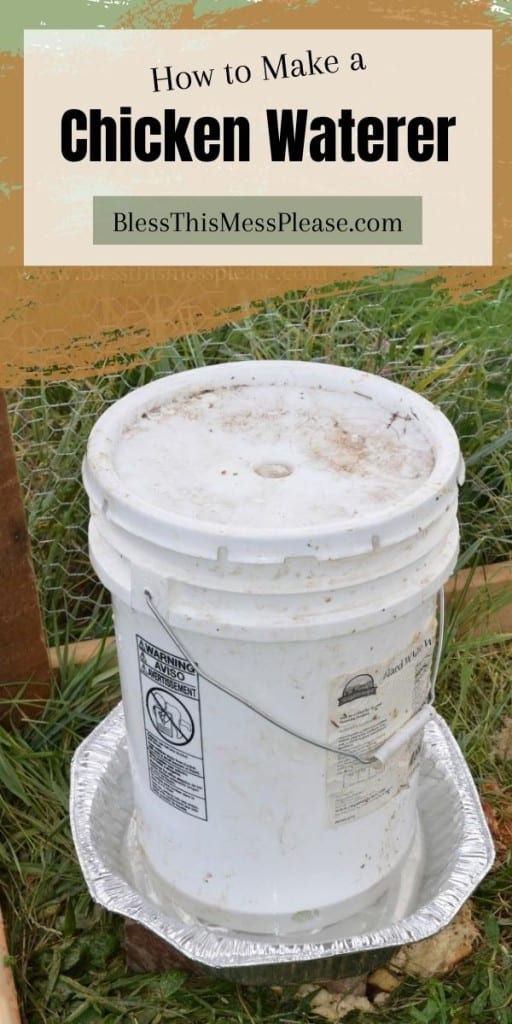
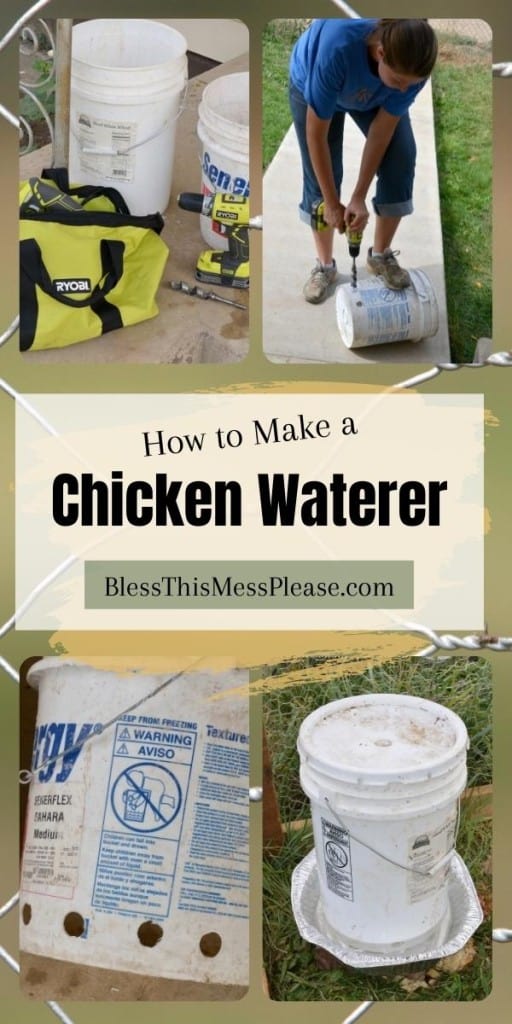
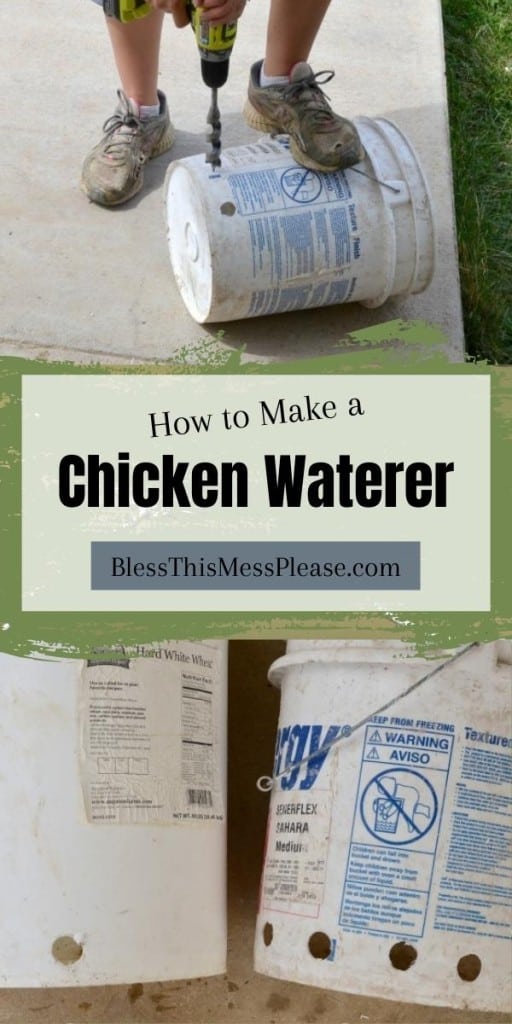
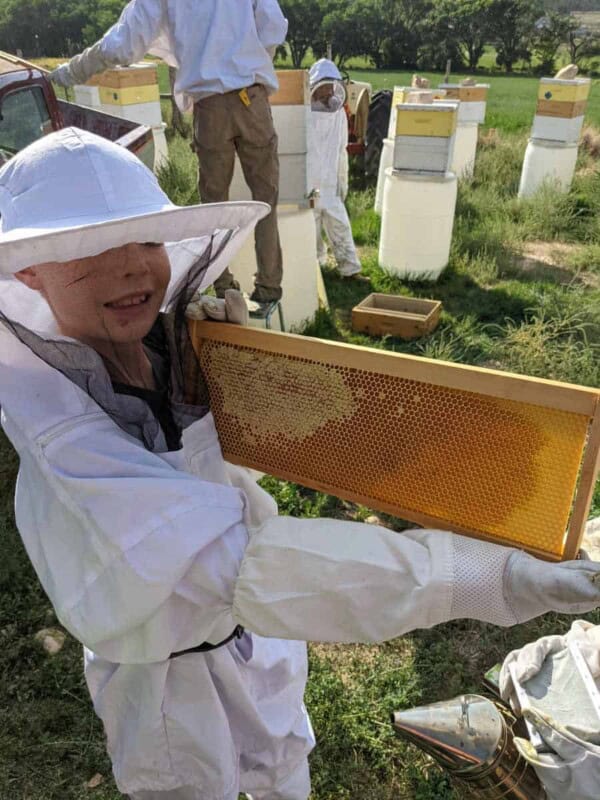
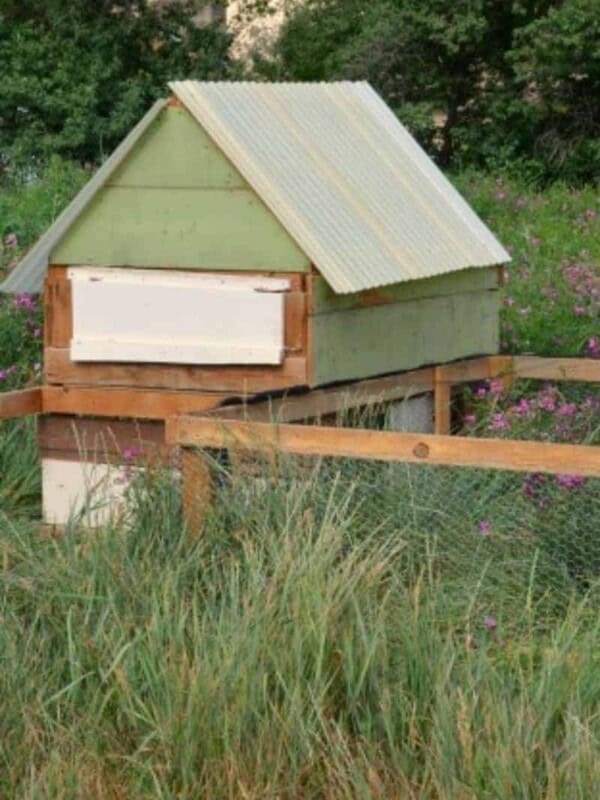

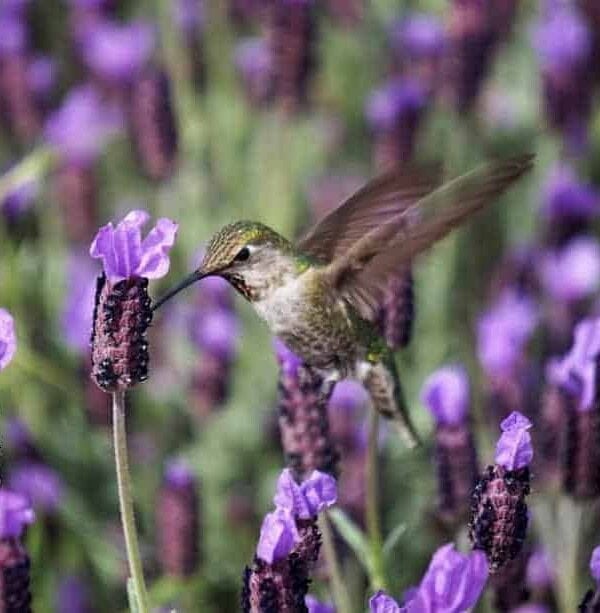






Great great idea and am new to rearing chickens
So what’s the point of the 5 gallon bucket if the water level is only slightly above the holes?
As the chickens drink, it refills itself! You have 5 gallons of water there and waiting for them to use it! It’s awesome.
This did not work for me! Did exactly as Instructed..drilled the two holes and the water keeps coming out! I have the metal pan higher than the holes..you said the seal on the lid is very important..so what happens when you dump in a bucket of water..it runs out..just above the holes in the bucket and container…if the seal is so important, what about the openings where the handle is? There is air getting in there…I don’t understand what I did wrong as I followed your instructions and this will not work
You essentially need a closed bucket with holes around the bottom. If you have an holes at the top the air will not make a vacuum and your water will run out. There shouldn’t be any holes near the handle. I’d try it again, once you get it to work it’s the best thing ever.
For folks having trouble with the vacuum, before you drill any holes, fill the bucket, put the lid on, turn it over. If any water comes out, you have vacuum issues and should not drill the holes in the bottom of the bucket. Instead, make a hole at the top of bucket or even in the lid if you want a very shallow pool. Then you fill the bucket, put lid on, and quickly turn the bucket over (lid on bottom inside the pan) and it will fill the pan to the level of the air hole. Because you don’t have holes in the bottom of your bucket (which is now at the top), you have a perfect suction up there.
For those with buckets without lids, you can still do this if you use a wire or strong bungee cord to keep the bucket from lifting off the pan. Take an open bucket, fill it, put the pan over the top and secure it to the bucket so it can not lift completely off the bucket, it can be loose, just not TOO loose. Turn it over and you’re done. Now go inside by the fire and dry out your pants because you probably spilled water on yourself. I didn’t say this was ideal, just doable.
Great tips and tricks, thank you so much for sharing!
Thank you for your great ideas.. I am always in trouble to see the poos of my chicken in the waterer and it was very small container..Now I got this and hoping yo make one…God bless you always…
The video shows as private and when I try to sign in, it says it’s unavailable. Bummer!
Thanks for letting me know, not sure why he took it down. I guess I’ll just have to make my own video!
Very simple but they work!
wish i’d seen this hint before i spent all that money for a 5 gallon waterer.
HELP, everytime I make one of these bucket waterers it does not stop filling ip the pan, it just runs over until the bucket is empty dow. to the hole.
What am I doin wrong?
If that is happening then the lid isn’t airtight and it’s not making a vacuum seal so the water will all leak out. I’d try a different bucket or a little caulk around the top before you pound the lid on! Good luck Caryn because once you get it to work you will LOVE IT!
Mine will stop flowing when I get the lid on but its hard to fill it up and get the lid on before the water is over flowing the tub. I can’t carry five gallons of water and neither can my kids. Suggestions?
We just keep the lid on and stick a hose in the hole to fill them up (while they are sitting upside down). I normally back them to and from the water with a wagon! Then all I have to do is flip them over into the pan.
I know this is an old post but was hoping for some help. I’m using new gamma seal lids and it still overflows until the bucket is empty. Any ideas?
I don’t think the gamma seal lids provide enough airtight suction for this. I have the best luck when I get pickle buckets from a restaurant that have a little screw on lid at the top (don’t pop off the whole top) they seem to work best. The gamma seal will work great for food though (and it will keep them sitting on the edge of a open bucket top and pooping in the food)!
Thankyou for your experience. …I’ll show it to my HUSBAND. ….MR.OVERKILL.
I just buried a potpourri warmer in the ground and hung my water container about 3 inches directly above it.
Can those waterers be made warm in winter by the addition of a bird bath heater with the cord sticking out the lid or would that cause all of the water to leak out?
The water would leak. You can stick the bottom pan on bricks (use 4, one on each corner) and place a 45 watt bulb underneath it. The heat from the bulb will keep it from freezing!